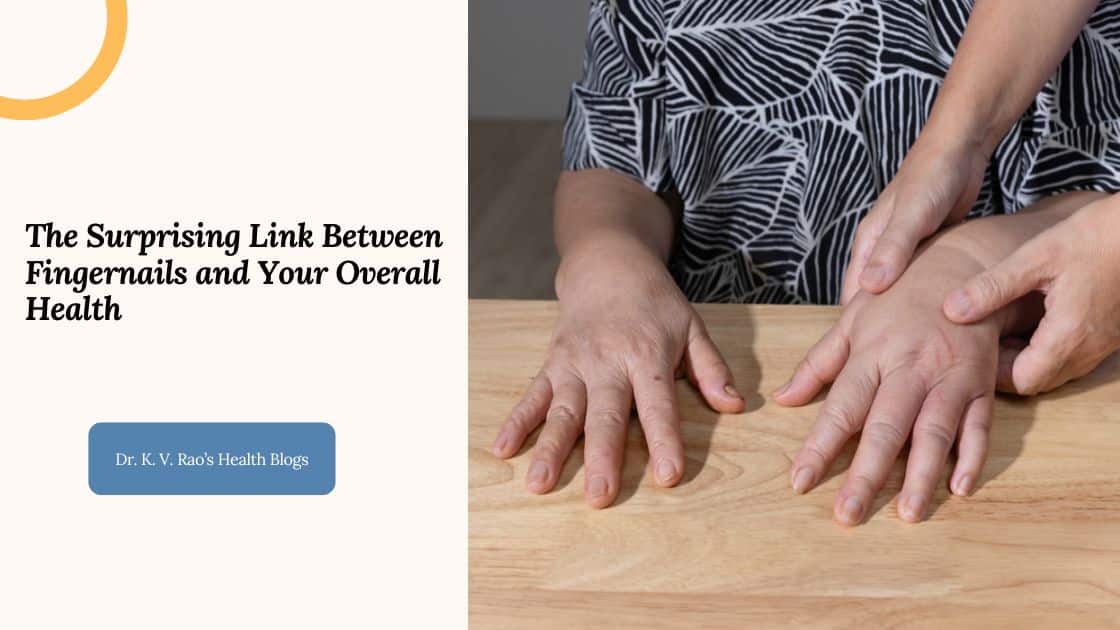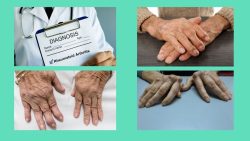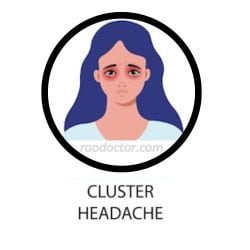Table of Contents
What your Fingernails tell you
Did you know that your fingernails could hold important clues about your overall health? It may come as a surprise, but your fingernails can reveal potential warning signs for various health conditions.
Recently, I wrote articles on how some essential minerals affect our health through excess or deficiency. On similar lines, the changes in fingernails show whether you are deficient or in excess of some nutrients, leading to concomitant ailments or illnesses.
From vitamin deficiencies to systemic diseases, keeping an eye on your fingernails can give you valuable insight into your well-being.
Dr. K.P. V. Rao’s Health Blogs
Listen to this article
This article delves into the surprising link between fingernails and your overall health, providing you with the knowledge to identify potential health issues at an early stage. By understanding what your nails are telling you, you can take proactive steps to improve your health and well-being.
So, the next time you glance at your hands, pay attention to your nails and discover the valuable health information they may hold. Stay tuned to unlock the secrets hidden beneath your fingertips.
Common Nail Abnormalities and Their Potential Health Implications
Your nails are not just a fashion statement; they serve as a window into your overall health. Various nail abnormalities can indicate underlying health conditions. Let’s explore some common nail abnormalities and what they may reveal about your well-being.
1. Discolored nails: Pay close attention to the color of your nails as it can often indicate certain health issues. For instance, yellow nails may be a sign of a fungal infection or even a symptom of diabetes.
Bluish nails might point to a lack of oxygen in your blood, while pale or white nails could indicate anemia or liver disease. If you notice any unusual color changes in your nails, it’s important to consult a healthcare professional for a proper diagnosis.
2. Thickened or brittle nails: If your nails are thickened or brittle, it could be a sign of a fungal infection, psoriasis, or an underactive thyroid. These conditions can cause changes in the nail structure, making them more prone to breakage and brittleness.
Additionally, certain medications and nutritional deficiencies can also contribute to these nail abnormalities. If you’re experiencing these issues, it’s advisable to seek medical advice to determine the underlying cause.
3. Spoon-shaped nails: Have you ever noticed your nails curving upwards, resembling the shape of a spoon? This condition, known as koilonychia, might indicate an iron deficiency or even hemochromatosis, a disorder where the body absorbs too much iron. Spoon-shaped nails can also be associated with heart disease and hypothyroidism. If you have this nail abnormality, it’s crucial to get a comprehensive evaluation to identify and treat any underlying health conditions.
Nail Color and What It Reveals About Your Health
The color of your nails can provide valuable insights into your health. By paying attention to any color changes, you can potentially detect health issues and take appropriate action. Let’s explore the different nail colors and what they may indicate about your overall well-being.
1. Pale or white nails: Nails that appear pale or white may indicate anemia, a condition characterized by low levels of red blood cells or hemoglobin. Furthermore, pale nails can be associated with liver disease, kidney problems, or malnutrition. If you notice a persistent paleness in your nails, it’s essential to consult a healthcare professional for further evaluation and appropriate treatment.
2. Yellow nails: Yellow nails are often attributed to fungal infections, particularly when they are thickened and crumbly. However, they can also signal more serious health conditions such as diabetes, psoriasis, or thyroid disease.
Additionally, smoking can cause yellow discoloration of the nails due to nicotine staining. If you have yellow nails that are not improving with basic nail care, seeking medical advice is recommended.
3. Blue nails: If your nails exhibit a bluish tint, it may indicate a lack of oxygen in your blood, a condition called cyanosis. Cyanosis can be a sign of lung or heart problems, such as chronic obstructive pulmonary disease (COPD) or congenital heart defects.
Raynaud’s disease, a condition where blood vessels constrict in response to cold temperatures or stress, can also cause blue discoloration of the nails. If you have persistent blue nails, it’s crucial to consult a healthcare professional to determine the underlying cause.
Nail Texture and What It Can Indicate About Your Well-Being
The texture of your nails can reveal important information about your overall well-being. Changes in nail texture can indicate underlying health conditions or deficiencies. Let’s explore some common nail textures and what they may signify.
1. Brittle nails: If your nails are constantly breaking, peeling, or splitting, it could be a sign of nutritional deficiencies, particularly a lack of biotin, vitamin E, or iron. Brittle nails can also be associated with conditions like hypothyroidism, psoriasis, or fungal infections.
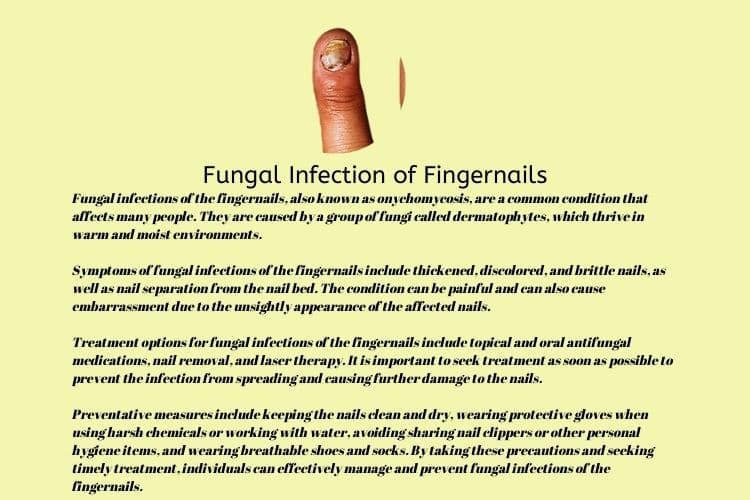
To improve nail health and combat brittleness, it’s important to ensure a balanced diet that includes essential nutrients and to keep your nails well-moisturized.
2. Pitted nails: Pitting refers to the presence of small dents or depressions on the surface of the nails. This nail texture is commonly associated with psoriasis, a chronic autoimmune condition that causes skin cells to multiply rapidly. Psoriasis can affect both the skin and nails, leading to pitting and other changes in nail appearance. If you notice pitted nails, it’s advisable to consult a dermatologist for an accurate diagnosis and appropriate treatment options.
3. Ridged nails: Vertical ridges on the nails are often a natural part of aging and pose no significant health concerns. However, horizontal ridges, also known as Beau’s lines, can indicate a more serious underlying condition. These ridges can be a result of trauma, severe illness, malnutrition, or even chemotherapy. If you have persistent horizontal ridges on your nails, it’s important to consult a healthcare professional to determine the cause and address any potential health issues.
Nail Shape and Its Connection to Certain Health Conditions
The shape of your nails can sometimes provide valuable clues about your health. While slight variations in nail shape are usually harmless, certain nail shapes can be associated with specific health conditions. Let’s explore some common nail shapes and their potential implications.
1. Clubbed nails: Clubbing refers to the enlargement of the fingertips and a downward curving of the nails. This nail shape is often associated with lung or heart problems, such as chronic lung infections, lung cancer, or congenital heart defects. Clubbing can also be a sign of inflammatory bowel disease or liver disease. If you notice clubbing of your nails, it’s crucial to consult a healthcare professional for further evaluation and appropriate management. Reference: Fingernail Clubbing.

2. Spoon-shaped nails: As mentioned earlier, spoon-shaped nails, also known as koilonychia, can indicate iron deficiency anemia, hemochromatosis, heart disease, or hypothyroidism. This nail shape is characterized by a concave shape, where the nail curves upwards, resembling a spoon. If you have spoon-shaped nails, it’s important to undergo a thorough medical evaluation to identify and address any underlying health conditions.
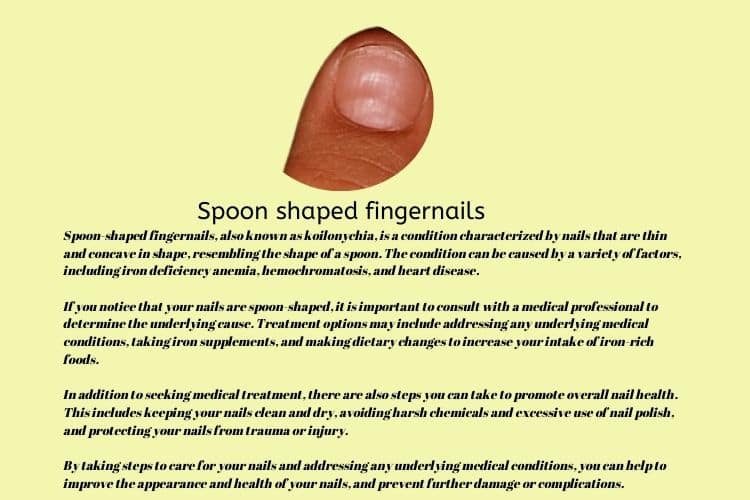
3. Pincer nails: Pincer nails, also called trumpet nails or omega nails, are characterized by an exaggerated curve of the nails. This nail shape can be associated with conditions like iron deficiency anemia, psoriasis, or fungal infections. Additionally, pincer nails can be hereditary. If you have pincer nails, it’s advisable to seek medical advice to determine the underlying cause and receive appropriate treatment if necessary.
Nail Growth Patterns and Their Significance in Diagnosing Health Issues
The growth patterns of your nails can provide valuable information about your health. Changes in nail growth can be indicative of certain underlying health conditions or deficiencies. Let’s explore some common nail growth patterns and what they may signify.
1. Slow nail growth: If your nails are growing at a significantly slower rate than usual, it may indicate a variety of health issues. Nutritional deficiencies, particularly of biotin, vitamin C, or iron, can affect nail growth. Certain medications, hormonal imbalances, and underlying health conditions like hypothyroidism or kidney disease can also lead to slow nail growth. If you notice a persistent slowdown in nail growth, it’s important to consult a healthcare professional to determine the underlying cause and appropriate management.
2. Pitting or rippling: When your nails develop small pits or ripples on the surface, it can be a sign of psoriasis or other autoimmune conditions. Psoriasis can affect both the skin and nails, leading to changes in nail growth patterns. If you have pitted or rippled nails, it’s advisable to consult a dermatologist for an accurate diagnosis and appropriate treatment options.
3. Beau’s lines: Beau’s lines are horizontal depressions or grooves that run across the nails. These lines can be caused by a variety of factors, including
- trauma,
- severe illness,
- malnutrition, or
- chemotherapy.
Beau’s lines occur when nail growth is temporarily disrupted, leading to visible lines on the nails. If you notice Beau’s lines on your nails, it’s important to consult a healthcare professional to determine the underlying cause and address any potential health issues.
Nutritional Deficiencies and Their Impact on Nail Health
Your nails require proper nutrition to grow strong and healthy. Nutritional deficiencies can affect the appearance and structure of your nails, making them more prone to breakage and other issues. Let’s explore some common nutritional deficiencies that can impact nail health and what you can do to address them.
1. Biotin deficiency: Biotin, also known as vitamin B7, plays a crucial role in maintaining healthy nails. A deficiency in biotin can lead to brittle nails that are more prone to breakage.
To address biotin deficiency, include biotin-rich foods in your diet, such as eggs, nuts, seeds, and whole grains. Additionally, biotin supplements may be recommended by your healthcare provider if necessary.
2. Iron deficiency: Iron deficiency can lead to brittle nails, spoon-shaped nails, or even the development of pale or white nails. Iron is essential for the production of hemoglobin, a protein that carries oxygen in your blood.
To increase your iron levels, consume iron-rich foods like lean meats, leafy green vegetables, legumes, and fortified cereals. In some cases, iron supplements may be prescribed by your healthcare provider.
3. Vitamin C deficiency: Vitamin C plays a vital role in collagen synthesis, which is important for maintaining the structure and strength of your nails. A deficiency in vitamin C can lead to weakened nails that are more prone to breaking.
To increase your vitamin C intake, include citrus fruits, berries, kiwi, and leafy green vegetables in your diet. Vitamin C supplements may also be recommended if needed.
4. Omega-3 fatty acid deficiency: Omega-3 fatty acids are essential for maintaining healthy nails and preventing dryness and brittleness. A deficiency in omega-3 fatty acids can result in nails that easily break or split.
To improve omega-3 fatty acid levels, consume fatty fish like salmon or mackerel, walnuts, chia seeds, and flaxseeds. Omega-3 fatty acid supplements may be beneficial in some cases.
Nail Care Tips for Maintaining Healthy Nails and Preventing Problems
Taking proper care of your nails is essential for maintaining their health and preventing potential problems. Here are some simple nail care tips to incorporate into your routine:
1. Keep your nails clean and dry: Clean your nails regularly with mild soap and water. Afterward, make sure to dry them thoroughly to prevent moisture buildup, which can lead to fungal infections.
2. Trim and file your nails properly: Trim your nails straight across and then round the tips with a nail file. Avoid cutting them too short, as this can increase the risk of ingrown nails.
3. Moisturize your nails and cuticles: Apply a moisturizer or cuticle oil to your nails and cuticles regularly to keep them hydrated and prevent dryness and brittleness.
4. Avoid harsh chemicals: When engaging in household chores or using cleaning products, wear gloves to protect your nails from harsh chemicals that can weaken and damage them.
5. Don’t bite or pick at your nails: Biting or picking at your nails can cause trauma and lead to infections or other nail problems. If you’re having difficulty breaking this habit, consider seeking professional help or using products designed to discourage nail-biting.
6. Use nail polish and nail polish remover sparingly: Frequent use of nail polish and nail polish remover can weaken your nails. Allow your nails to breathe by leaving them polish-free for a few days between applications.
7. Avoid excessive use of artificial nails or nail extensions: While they may enhance the appearance of your nails temporarily, excessive use of artificial nails or nail extensions can weaken your natural nails and increase the risk of infections.
By incorporating these nail care tips into your routine, you can maintain healthy nails and minimize the risk of potential nail problems.
When to Seek Medical Attention for Nail-Related Concerns
While many nail abnormalities can be harmless, some may require medical attention. It’s important to know when to seek professional help for any nail-related concerns.
Here are some situations that warrant a visit to a healthcare professional:
1. Persistent nail changes: If you notice persistent changes in your nails, such as discoloration, texture abnormalities, or changes in nail shape or growth patterns, it’s advisable to consult a healthcare professional. They can evaluate your nails, conduct necessary tests, and provide an accurate diagnosis.
2. Pain or discomfort: If you experience pain, swelling, or discomfort around your nails or nail beds, it may indicate an infection or other underlying condition. Seeking medical attention can help identify the cause and provide appropriate treatment.
3. Signs of infection: If you notice signs of infection, such as redness, pus, or increasing pain around your nails, it’s important to seek medical attention promptly. Infections can lead to more serious complications if left untreated.
4. Nail injuries: If you injure your nail, such as crushing it or tearing it away from the nail bed, it’s crucial to seek medical attention. Your healthcare provider can assess the extent of the injury and provide appropriate treatment to prevent complications.
Remember, it’s always better to be safe than sorry when it comes to your health. Consulting a healthcare professional can provide you with peace of mind and ensure timely intervention if needed.
The Importance of a Balanced Diet and Proper Nutrition for Healthy Nails
Maintaining healthy nails goes beyond external care; it also involves nourishing your nails from within. A balanced diet that provides essential nutrients is crucial for healthy nails.
A balanced diet rich in vitamins and minerals is essential for promoting nail health. Nutrients like biotin, vitamin E, iron, and zinc are all crucial for maintaining strong and beautiful nails. Including foods such as eggs, nuts, leafy greens, lean meats, and whole grains in our diet can provide us with these essential nutrients.
By nourishing our bodies from within, we can see the impact on our nails, making them stronger and less prone to brittleness or splitting.
Proper nutrition is not only important for the health of our nails but also for their appearance. When we provide our bodies with the right nutrients, we can enhance the natural shine and color of our nails.
By consuming foods rich in omega-3 fatty acids, such as salmon or flaxseeds, we can promote a healthy nail bed and prevent dryness or dullness. Including fruits and vegetables in our diet can also contribute to vibrant and healthy nails.
Conclusion
In conclusion, maintaining a balanced diet and ensuring proper nutrition is crucial for the health and appearance of our nails. By providing our bodies with the necessary vitamins, minerals, and nutrients, we can promote strong, beautiful nails that we can be proud of. So let’s make sure to prioritize our nail health by incorporating a variety of nutritious foods into our daily diet!
Final words
I hope you have found this article very useful. If yes, do share it on the social media icons at the bottom of this article. Alternately, you can share by Clicking to Tweet here-
The Surprising Link Between Fingernails and Your Overall Health Share on XMy next article will be skin disorders that causes white and dark patches. Do bookmark Dr. K. P. V. Rao’s Health Blogs to read future articles.

